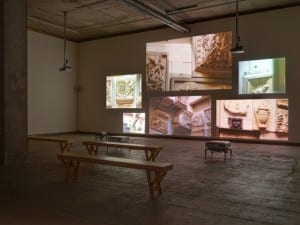Italian-born and Berlin-based artist Monica Bonvicini (b. 1965) is best known for her one-way mirrored glass toilet outside the Tate Britain in 2004 and her light installation RUN in the London Olympic Park. But for her hand around the room at BALTIC Centre for Contemporary Art, Gateshead, the relationship between architecture and sexuality is evident. Choosing industrial subjects with S&M-inspired materials, the formality of spaces is reconstructed conceptually, considering presence, shape and connotations.
Speaking exclusively with Phaidon for a comprehensive monograph, Bonvicini notes: “If one really believes that the personal is political, then the first scene of the crime is the bed. “I read very early on Freud’s The Psychopathology of Everyday Life, Carl Jung, Eric Fromm, Wilhelm Reich. I learned about the Marxist concept of fetishism in high school, where I was lucky enough to have a great economics teacher who had studied sociology with [Red Brigade leader, Renato] Curcio in Trento back in the good old days. I was also interested in Franco Basaglia’s idea of democratic psychiatry, which was still much discussed when I was a teenager. Confining people, defying sicknesses and diseases, are things that I always found rather creepy.”
Spread across the Level 3 and Level 4 Galleries of BALTIC, a career full of specially commissioned works alongside personal contributions are displayed as fabricated environments. For example, Light me Black, made from 144 fluorescent lights overpowers the viewer as a suspended structure. Equally menacing as mesmerising, the 2009 installation uses white metal fixtures, steel and electrical cables, icons of the contemporary industrialism, to convey a body which is beautiful and simultaneously overbearing.
Other notable pieces showcased within the survey include the 2007 NOT FOR YOU and Scale of Things (to come), a staircase of chains and steel pipes, that tread a fine line between the aesthetic and the sinister. Creating intriguing contrasts between the sexual and the monumental, Bonvicini’s alluring collections create larger statements about the value of buildings and their semantically charged elements.
“Architecture, as an institution, is about corruption, dreams, state ambitious, abuse, class power, money, the representation of authority. All dictators and magnanimous state presidents use architecture as a way, or as an excuse, to connect politics with culture, and of course to ‘build’ history as well.”
her hand around the room is at BALTIC Centre for Contemporary Art, Gateshead, until 26 February. www.balticmill.com
Credits:
1. Monica Bonvicini, Light Me Black (2009). Courtesy of Baltic Mill.





